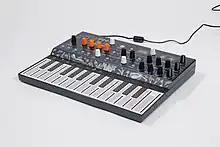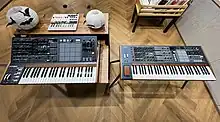| MicroFreak | |
|---|---|
 The MicroFreak (taken at NAMM) | |
| Manufacturer | Arturia |
| Technical specifications | |
| Polyphony | 4 (paraphonic) |
| Timbrality | Monotimbral |
| Oscillator | Single Multi-Mode Digital Oscillator |
| LFO | Multi-shape LFO |
| Synthesis type | See Sound Engines |
| Filter | Multi-mode VCF |
| Attenuator | Cycling envelope, ASR envelope and LFO |
| Aftertouch expression | Polyphonic Aftertouch |
| Input/output | |
| Keyboard | 2 Octave PCB |
| External control | Sends and receives MIDI, outputs CV |
The MicroFreak is a synthesizer manufactured by French music technology company Arturia and released in 2019.[1] Described as a "Hybrid Experimental Synthesizer", it uses 18 digital sound engines (algorithms) to synthesize raw tones.[2] This digital oscillator is then fed into a multi-mode analog filter, giving the MicroFreak its hybrid sounds.
Sound engines
The MicroFreak has 22 distinct sound engines (as of the 5.0 update).[3]
They are:[4]
- Basic Waves – a standard synth voice using traditional waveforms
- Super Wave – a group of detuned waves (like a supersaw),
- Harmonic – a form of additive synthesis where you set volumes of frequencies individually,
- Karplus-Strong – a physical modelling system to replicate string sounds,
- Wavetable – a method of synthesis where the waveform transitions through a table of different waveforms,
- Noise – various types of noise and static.
- Virtual Analogue – a standard subtractive synth voice,
- Waveshaper – a triangle wave that is repeatedly wavefolded,
- Frequency Modulation (two operators) – a method of synthesis where a wave modulates the frequency of another wave,
- Formant – a form of granular synthesis,
- Chords – an engine that plays groups of notes paraphonically,
- Speech – a vocal synthesizer,
- Modal – a physical modelling engine that replicates the sound of hollow objects,
- Bass – another waveshaping algorithm specifically for basslines,
- Harm – a mixture of waveshaping and additive synthesis,
- SawX – a supersaw being phase modulated,
- Vocoder – a voice transformer similar to a talkbox,[5]
- User Wavetable – an engine to use your own wavetables,
- Sample – an engine that plays back loaded samples,
- Scan Grain – a granular synthesizer that scans through a whole sample,
- Cloud Grain – a granular synthesizer that creates overlapping grains from a sample, and
- Hit Grain – a granular synthesizer that creates percussive sounds from a sample.
Of those, 12 are made by Arturia (Basic Waves, Super Wave, Harmonic, Karplus-Strong and Wavetable, Noise, Vocoder, User Wavetable, Sample, Scan Grain, Cloud Grain, and Hit Grain), 7 are made by Mutable Instruments (Virtual Analogue, Waveshaper, Two operator FM, Formant, Chords, Speech and Modal) from their "Plaits" eurorack module,[6] and the remaining 3 are made by Noise Engineering.[7]
Firmware updates
Arturia made available user installable firmware updates for the MicroFreak with additional features and improvements in the years after the original release.[8][9]
- 1.0 – MicroFreak released with this firmware
- 2.0 – Added noise engine, chord mode and scale quantisation
- 2.1.3 – Added vocoder engine. Vocoder edition released with this firmware.
- 3.0 – Added noise engineering oscillators, unison mode and more preset slots
- 4.0 – Added user wavetable engine and 64 more preset slots[10]
- 5.0 – Added sample and grain engines, 128 more preset slots, and a sample and hold mode for keybed modulation. The Stellar edition released with this firmware.[3]
Variations
It received a limited edition white Vocoder design in 2020. [5]

Reception
It is considered by some to be one of the best value for money synthesizers of modern times.[11][12] According to the music production website MusicTech it has "an enormous amount to offer and will really reward exploratory use".[12] The MicroFreak was popular due to its many sound engines and modulation options.[13][14] The MicroFreak received 9/10 from MusicTech (MusicTech Choice Award);[12] and 9/10 from MusicRadar.[11]
See also
- Arturia MiniBrute – another synthesizer by the same company
References
- ↑ Perrier, Morgan. "Arturia - MicroFreak - MicroFreak". www.arturia.com. Retrieved 2022-10-13.
- ↑ Perrier, Morgan. "Arturia - MicroFreak - MicroFreak". www.arturia.com. Retrieved 2022-10-13.
- 1 2 O'Brien, Terrence (2023-05-10). "Arturia's MicroFreak gets sample playback, granular synthesis and gorgeous Stellar edition". engadget.com. Retrieved 2023-05-11.
- ↑ "Microfreak Oscillators". Arturia.
- 1 2 Rogerson, Ben (2020-08-25). "Arturia releases MicroFreak Vocoder Edition, and there's a pleasant surprise for owners of the original synth, too". MusicRadar. Retrieved 2022-10-25.
- ↑ "About the Microfreak". Mutable Instruments' community. 2019-01-25. Retrieved 2022-10-25.
- ↑ Arblaster, Simon (2021-01-14). "Arturia collaborates with Noise Engineering to bring exciting new features to latest MicroFreak firmware update". MusicRadar. Retrieved 2022-10-25.
- ↑ "Arturia MicroFreak review". MusicRadar. 2019-05-15. Retrieved 2022-10-25.
- ↑ Perrier, Morgan. "Arturia - MicroFreak - MicroFreak". www.arturia.com. Retrieved 2023-06-07.
- ↑ Mullen, Matt (2021-10-26). "Arturia's V4.0 MicroFreak firmware update adds WaveUser synth engine and 64 new presets". MusicRadar. Retrieved 2022-10-25.
- 1 2 "Arturia MicroFreak review". MusicRadar. 2019-05-15. Retrieved 2022-10-25.
- 1 2 3 "Review: Arturia MicroFreak". MusicTech. Retrieved 2022-10-25.
- ↑ "Best Synthesizers for Beginners - Perfect Circuit". www.perfectcircuit.com. Retrieved 2023-03-10.
- ↑ "A beginners guide to buying a synth". Engadget. Retrieved 2022-10-25.